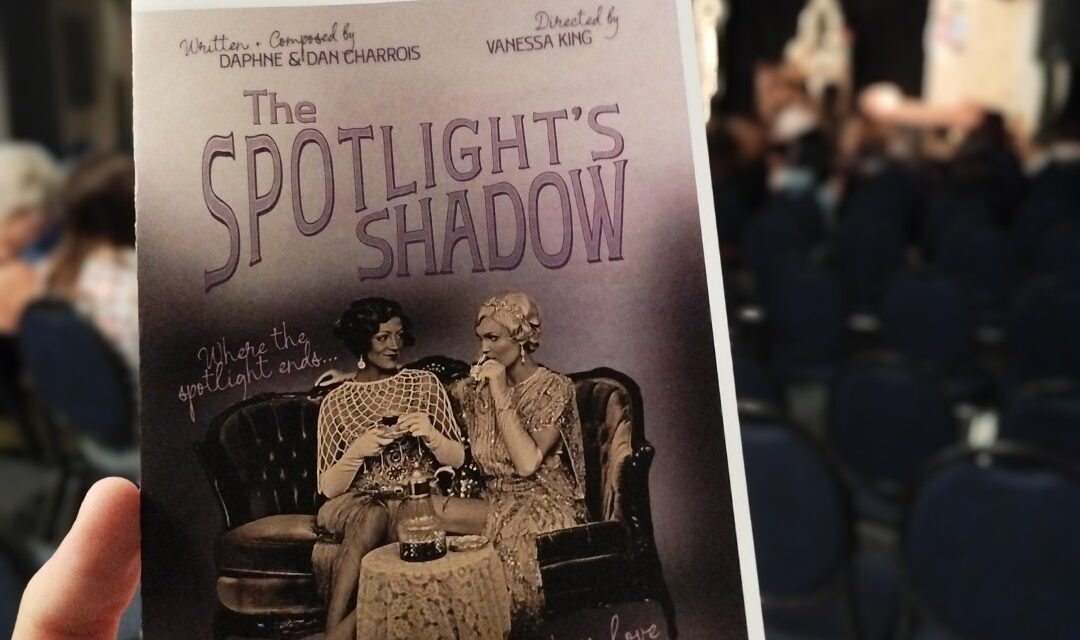The Warm Afterglow of Backstage Love
Review by Daniel Greenways
Book & Lyrics by: Daphne Charrois
Composed by: Dan Charrois
Directed by: Vanessa King
Starring: Grace Bokenfohr & Daphne Charrois
Designed by: Jeannie Charrois, Krista Johnson, Karen Suchla
Stage Manager: Avry Thompson
Assistant Stage Manager: Lola Manning
Voice-over: Keegan Mabbutt
Intimacy Coordinator: Mika Boutin
Café Bicyclette Stage (Venue 14)
(Real) Runtime: 63 minutes
★★★☆☆
3/5 stars
True to its name, The Spotlight’s Shadow is mostly about that which lingers outside the spotlight’s reach. The play is set in the roaring 20s, full of sequins, gowns and powdered noses. Here we meet Nettie (Grace Bokenfohr), an established member of the illustrious Ziegfeld Follies. When the lights come up, we find her in the dressing room just as an aspiring auditionee named Vera (Daphne Charrois, who is also the playwright and lyricist) stumbles through the door and into her life. The two rehearse Vera’s number together, share a few furtive glances, and we are off to the races. Vera is soon in the cast, and their flirting quickly develops into a backstage romance that lasts from 1925 to 1929. This love affair, taboo in the prying eyes of the early 20th century, is the product of the safe shadows the pair enjoy outside of the spotlight’s glare. However, as time goes on and each want more than a covert fling, these shadows begin to look more like a prison than a refuge.
The intimacy of this backroom drama is probably its most compelling side. Bokenfohr and Charrois brought a kind of tender, beating-heart sincerity to these exchanges that set the tone of the play as it reached its crescendo. This intimacy was really where we got to know the characters. Outside of their moments of physical attraction, one often felt that there was still an air of distance and formality to each scene. Ironically, for a play that takes place backstage, it was often as though both characters were still dolled up in front of the footlights. This may have been a conscious decision, as the 1920s were more formal times. At one point, Vera even bemoans these social limits, saying “I just hope you let someone see the real you, even if it is only me.” It is hard to balance period accuracy with the unknown space of private life, and the play’s heavy touch here added some layers of removal.
Another thing that could have used less removal was the play’s main action. As Nettie and Vera face waves of pushback and subterfuge, almost all of the play’s tension found itself off-stage. This is the curse of the one-room play with the two-person cast. It often happens that the battle is taking place in the shadow of The Spotlight’s Shadow, forcing a lot of exposition to keep us in the loop. This has its pros and cons. The play felt much cozier being restricted to the dressing room, but I often wondered what the rest of the Follies must look like, and what energy there must be outside the stage door.
Perhaps the most impressive part of The Spotlight’s Shadow is that it is a new work, and features four songs composed locally by Dan Charrois. It is surely a feather in the cap of Light in the Attic Productions that they managed to put out a whole new musical. Anyone who has even put up a musical knows how hard it is, without having to write it yourself. That being said, the type of music in The Spotlight’s Shadow sometimes felt a bit safe. It was sometimes disconcerting to see this soft, historical love story – set in a time on Broadway known for certain music styles – interspersed by distinctly modern musical numbers. There is something direct about contemporary musical compositions that just felt out of place for the story and the time period. Adding to this feeling, the play actually opens with a classic love-song from 1910: “Let Me Call You Sweetheart.” This first number fits Bokenfohr’s voice especially well, probably a nod to her time with Opera McGill. Throughout the play, she finds her niche in those moments where the warm tone of her voice had space to really open up. Charrois’ voice was well suited to the musical numbers that followed, and had a sharp, crisp and modern edge. The two often combined forces at the end of a scene for some delicious harmonies.
Without spoiling anything, I would be remiss not to mention that the last scene is particularly good and ends the play on a high note. In a musical that often feels predictable, the ending was a pleasant surprise and raised the bar substantially with regard to the symbolism and grit of the production. Although the play was occasionally a bit on-the-nose with its message, there was a lot to like about this one. If you like tender romance, new musicals, or empowering, positive queer stories, check it out.


